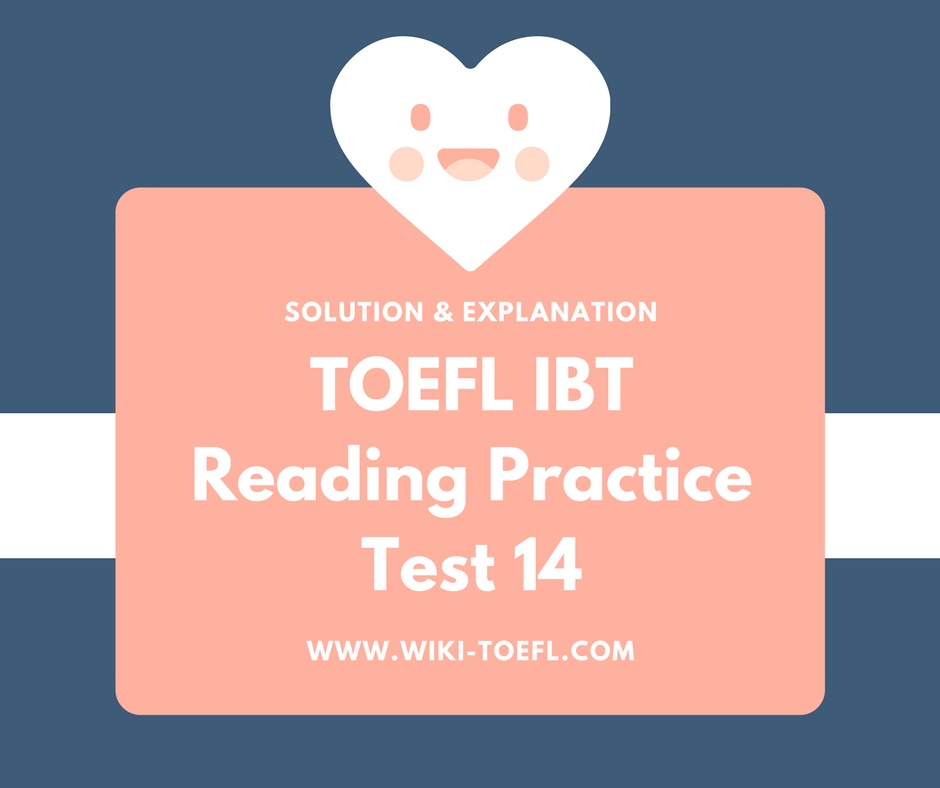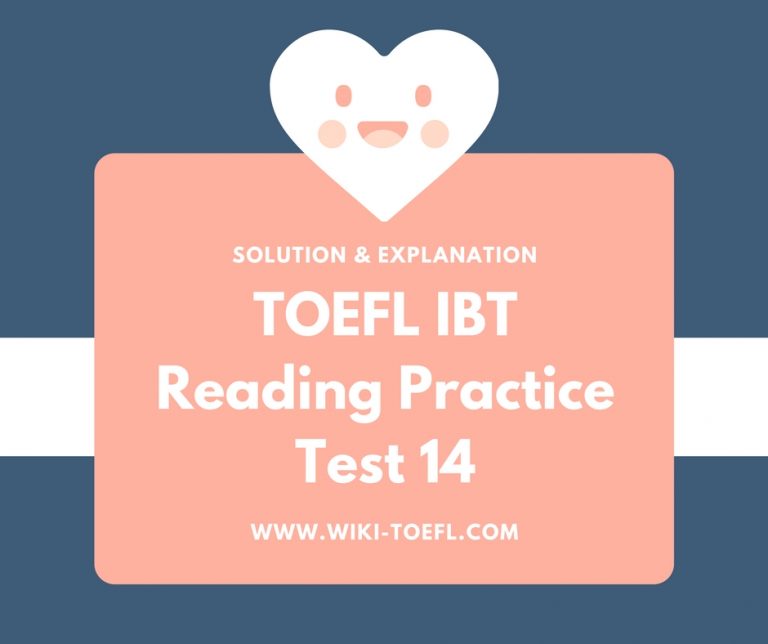SOLUTION & EXPLANATION FOR TOEFL IBT READING PRACTICE TEST 14 ( FROM BARRON’S TOEFL IBT)
Reading 1 “Beowulf”
1. C “…Beowulfwas written by an anonymous [author unknown] Englishman in Old English.”
Choice A is not correct because it is one of four surviving manuscripts. Choice B is not correct because it was written in old English about Germanic characters. Choice D is not correct because scholars do not know if it is the sole surviving epic from about a.d. 1000.
2. B “Although Beowulf was written by an anonymous Englishman in Old English, the tale takes place in that part of Scandinavia from which [that part of Scandinavia] Germanic tribes emigrated to England.”
3. A “Iron was accessible everywhere in Scandinavia, usually in the form of ‘bog iron’ found in the layers of peat in peat bogs.” Choice B is not correct because the author had already stated that the best swords had iron or iron-edged blades. Choice C is not correct because the Celts taught the Northmen how to use the materials, but they did not provide the bog iron. Choice D is not correct because the bog iron does not relate to the date, although 500 b.c. is mentioned as the time when the Northmen learned how to forge iron.
4. A Society in Anglo-Saxon England paraphrases “Anglo-Saxon society.” … both advanced para phrases “neither primitive,” and cultured paraphrases “nor uncultured.” Two negatives [nor and -un] produce an affirmative meaning.
5. B In this passage, rare is a synonym for “unique.” Context comes from the reference to the “sole surviving epic” in the beginning of the same sentence.
6. B “… the original manuscript was probably lost during the ninth century…. in which the Danes destroyed the Anglo-Saxon monasteries and their great libraries.” Choice A is true but it is not the reason that scholars believe the original manuscript was lost. Choice C is not correct because the Danes were invaders, not poets. Choice D is not correct because the location of the discovery is not mentioned, although the author may have been a monk.
7. D “Although the Beowulf manuscript was written in about a.d. 1000, it was not discovered until the seventeenth century.” Choice A is not correct because the first century was the date the manuscript was written, not discovered. Choice B is not correct because the ninth century was the date when the original manuscript may have been lost. Choice C is not correct because some scholars think that the manuscript was written in the eleventh century.
8. A Because the word “apparently” means “appearing to be so,” the author is expressing doubt about the information that follows, “… [the Beowulf poet] was a Christian.” Choice B is not correct because the word “obviously” would be used. Choice C is not correct because the phrases “for example” or “for instance” would signal an example. Choice D is not correct because evidence would not be presented as “appearing to be so.”
9. A “.. . Beowulf is a very appealing hero … Like Hercules.” Choice B is not correct because a fight with a dragon is mentioned in reference to Beowulf but not to Hercules. Choice C is not correct because the Danish hero’s welcome is the only reference to a speech, and it was jealous, not inspiring. Choice D is not correct because the time period for the life of Hercules is not mentioned.
10. B In this passage, demonstrates is a synonym for “exhibits.”
11. C In this passage, refuse is a synonym for “reject.” Context comes from the contrast with “accept” in the previous sentence.
12. C Addition is a transitional device that connects the insert sentence with the previous sentence.
Moreover signals that additional, related information will follow. “. . . they [scholars] disagree” refers to “Scholars do not know” in the previous sentence.
13. E, D, F summarize the passage. Choice A is true, but it is a minor point that establishes the time period for the poem and refers to major point D. Choice B is true, but it is a detail that refers to major point E and explains why there may be only one manuscript. Choice C is not clear from the information in the passage.
Reading 2 “Thermoregulation”
14. A “The most basic mechanism [for maintenance of warm body temperature] is the high meta bolic rate.” Choices B, C, and D are all ways to maintain body temperature, but they are not the most fundamental adaptation.
15. D “In some mammals, certain hormones can cause mitochondria to increase their metabolic activity and produce heat instead of ATP. This non shivering thermogenesis (NST). . . .” Choice A is not correct because thermogenesis is the activity that generates heat, not the heat loss. Choice B is not correct because brown fat is one example of a more generalized process. Choice C is not correct because thermogenesis is a response to the environment to maintain the health of the animal, not a process that maintains the environment.
16. B A passive grammatical structure in the passage is paraphrased by an active grammatical structure in the answer choice.
17. D In this passage, smallest is a synonym for “minimal.”
18. B “For example, heat loss from a human is reduced when arms and legs cool.” Choice A is not correct because goose bumps, not heat loss in the extremities, is a vestige of our evolution. Choice C is not correct because no direct comparisons of -these processes are made in the paragraph. Choice D is not correct because the types of insulation are mentioned before the concept of vasodilatation and vasoconstriction are introduced.
19. D In this passage, control is a synonym for “regulate.” Context comes from the reference to “tem perature differences” at the end of the same sentence.
20. B “The loss of heat to water occurs 50 to 100 times more rapidly than heat loss to air.” Choice A is not correct because hair loses insulating power when wet, but the evolution of marine animals is not mentioned. Choice C is not correct because dry hair insulates better than wet hair. Choice D is not correct because there are land animals that are of similar size.
21. D “… marine mammals maintain body core temperatures of about 36-38°C with metabolic rates about the same as those [metabolic rates] of land mammals of similar size.”
22. A “. . . capable of astonishing feats of thermoregulation. For example, small birds called chickadees … hold body temperature nearly constant.” Choice B te not correct because the food supply supports thermoregulation, which is the main point of the example. Choice C is not correct because chickadees are capable of astonishing feats of thermoregulation. Choice D is not correct because the reason for heat production in animals is explained before the example of the chickadee.
23. D Choice A is mentioned in paragraph 6, sentence 7. Choice B is mentioned in paragraph 6, sentence 8. Choice C is mentioned in paragraph 6, sentences 3 and 4.
24. B In this passage, improve is a synonym for “enhance.” Context comes from the reference to “promote” in the previous sentence.
25. A Reference is a transitional device that connects the insert sentence with the previous sentence. “… a layer of fur or feathers” and “how much still air the layer [of fur or feathers] traps” in the insert sentence refers to “… fur or feathers” and “a thicker layer of air” in the previous sentence.
26. E, C, F summarize the passage. Choice A is a minor point that supports major point C. Choice B is true but it is not mentioned in the passage. Choice D is a minor point that supports major point F.
Reading 3 “Social Readjustment Scales”
27. D “Overall, these studies have shown that people with higher scores on the SRRS tend to be more vulnerable to many kinds of physical illness ” Choice A is not correct because a person with a higher score will experience more, not less, stress. Choice B is not correct because the numerical values for major problems are not identified, and a score of 30 does not have meaning unless it is compared with a higher or lower score. Choice C is not correct because the effects of positive or negative change are not mentioned in the first two paragraphs.
28. C “… the desirability qf events affects adaptational outcomes more than the amount of change that they [events] require.”
29. D In this passage, different is a synonym for “diverse.”
30. C “. .. divorce may deserve a stress value of 73 for most people, a particular person’s divorce might generate much less stress and merit a value of only 25.” Choice A is not correct because a particular person is compared with most people. Choice B is not correct because the serious nature of divorce is not mentioned. Choice D is not correct because the numerical value of 73 for most people is questioned.
31. A “… what qualifies as trouble with the boss’? Should you check that because you’re sick and tired of your supervisor? What constitutes a ‘change in living conditions’? Does your purchase of a great new sound system qualify?” Choice B is not correct because the author does not offer examples of responses to the questions posed. Choice C is not correct because options for scores are not provided in paragraph 5. Choice D is not correct because the author suggests that people do not respond consistently but whether they respond carefully is not mentioned.
32. B . subjects’ neuroticism affects both their responses to stress scales and their self-reports of health problems.” Choice A is not correct because they recall more symptoms, but they are not ill more often. Choice C is not correct because they recall more stress, but they do not necessarily suffer more actual stress. Choice D is not correct because the effects of neuroticism obscures the meaning of the scores that are recorded.
33. C In this passage, arranged is a synonym for “assembled.”
34. C In this passage, related is a synonym for “relevant.”
35. B “… dropping the normative weights and replacing them with personally assigned weightings.”
Choice A is not correct because long-term consequences are not included in positive, negative, and total change scores. Choice C is not correct because the differences in people reflect their appraisal of stress, not how they handle stress. Choice D is not correct because normative weighting is replaced by personally assigned weightings.
36. C In paragraph 1, the authors state that the SRRS “… assigns numerical values.” Choices A and B are not correct because they are mentioned in paragraph 10 in reference to the LES, not the SRRS. Choice D is not correct because recalling events from one year ago is a problem on the SRRS.
37. A “The LES deals with the failure of the SRRS to sample the full domain of stressful events.”
Choice B is not correct because the author explains several ways that the LES deals with the failure of the SRRS. Choice C is not correct because it has been used in thousands of studies by researchers all over the world. Choice D is not correct because the LES, not the SRRS, has a special section for students.
38. B Reference is a transitional device that connects the insert sentence with the previous sentence. “This sum” in the insert sentence refers to the phrase “adds up the numbers” in the previous sentence.
39. SRRS: A, H, I LES: B, D, E, G Not used: C, F

